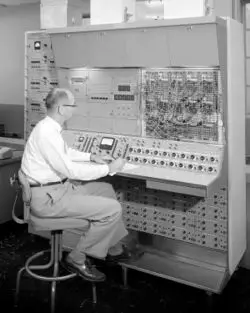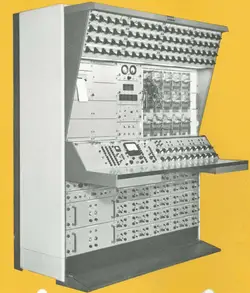m |
m |
||
| Line 2: | Line 2: | ||
{{analog computer | {{analog computer | ||
|title = PACE 231R | |title = PACE 231R | ||
| − | |image = | + | |image = EAI PACE 231R (NASA, 1960).jpg |
| − | |caption = | + | |caption = PACE 231R, NASA/Glenn Research Center, 6/6/1960 |
|developer = [[Electronic Associates]] | |developer = [[Electronic Associates]] | ||
|manufacturer = [[Electronic Associates]] | |manufacturer = [[Electronic Associates]] | ||
Revision as of 15:18, 22 December 2015
| PACE 231R | |

| |
| PACE 231R, NASA/Glenn Research Center, 6/6/1960 | |
| Developer | Electronic Associates |
| Manufacturer | Electronic Associates |
| Product family | PACE Series |
| Type | analog computer |
| Release date | 1958[1] |
| Introductory price | $20,000-1,000,000[1]
|
| | |
| Operating Range | +/- 10V |
| Components |
|
The PACE 231R was an analog computer developed by Electronic Associates in 1958[1]. The 231R was EAI's flagship computer becoming the most widely used analog computer system in the world - operating in various places well into the late 1970s and even early 1980s.
The EAI 231R is notable for having been used for simulation in many of the early space and aviation projects including the Project Mercury, Project Gemini, and the X-15.
Contents
Details
| This section is empty; you can help add the missing info by editing this page. |
Notable installations/applications
X-15
In 1956, during the development of the North American X-15, no digital computer had the performance capabilities of delivering flight simulation calculations in real time which is why NASA chose the EAI PACE 231R analog computer instead. Three EAI 231R computers, containing 380 operational amplifiers, 101 function generators, 32 servo amplifiers, and 5 electrical multipliers networked together made up the simulator. The simulator covered 0.2 to 7.0 Mach at altitudes from sea level to 1,056,000 feet. It was not, however, capable of providing meaningful landing simulations. [2]
Langley Research Center / Project Mercury
In June 1960 EAI won a $1.51M contract to supply NASA's Langley Research Center with five fully expended PACE 231R systems. Those systems were used for various aspects of the Mercury project, including space station rendezvous. It was also used for the simulation of missile launches and satellites.[1]
Others
- NASA
- Goodard Space Flight Center, Washington DC
- Space Task Unit, Langley Research Center
- Ames Research Center, Moffet Field
- Manned Space Flight Center, Houston Texas
- United Kingdom Atomic Energy Authority
Documents
References
- ↑ 1.0 1.1 1.2 1.3 Small, James (2013). The Analogue Alternative: The Electronic Analogue Computer in Britain and the USA, 1930-1975. Routledge, 46. ISBN 9781134699025.
- ↑ Jenkins, Dennis (2012). X-15: Extending the Frontiers of Flight. NASA (EBook), Chapter 6.
- ↑ 3.0 3.1 Fry, Peter (2015). Remembering AEE Winfrith: A Technological Moment in Time. Amberley Publishing, 118-119. ISBN 9781445654799.

